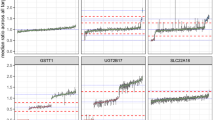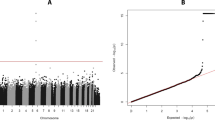Abstract
Objective
The nuclear receptor NR1I2 (also called PXR or SXR) is primarily expressed in mouse and human liver and intestines. Direct activation of NR1I2 occurs in response to a range of xenobiotics, which causes the formation of a heterodimer with the RXR receptor. This heterodimer binds to the nuclear receptor response elements of downstream genes such as ABCB1, CYP2C, and CYP3A. This study determined the extent of NR1I2 variation in three world populations.
Methods
Variation in NR1I2 was identified by pooled resequencing in African, Asian, and European populations. Validation was performed in European and African populations using PCR and Pyrosequencing technology. RNA expression of NR1I2, ABCB1 and CYP3A4 was assessed using real-time PCR.
Results
Of 36 single nucleotide polymorphisms (SNPs) identified, 24 were in the untranslated region, 8 were intronic, and 4 exonic. Thirty-six percent were unique to the African population. In comparison with previously published data, we identified 13 novel polymorphisms. The NR1I2 −566A > C polymorphism was significantly associated with ABCB1 and CYP3A4 RNA expression in colon tumor (P = 0.04 in both cases), however, this polymorphism was not associated with NR1I2 expression.
Conclusion
With NR1I2 playing such a large role in the regulation of genes involved in drug metabolism and transport, genetic variation contributing to altered NR1I2 function may have an important clinical impact.

Similar content being viewed by others
References
Ameyaw MM, Collie-Duguid ES, Powrie RH, Ofori-Adjei D, McLeod HL (1999) Thiopurine methyltransferase alleles in British and Ghanaian populations. Hum Mol Genet 8(2):367–370
Bertilsson G, Heidrich J, Svensson K, Asman M, Jendeberg L, Sydow-Backman M, Ohlsson R, Postlind H, Blomquist P, Berkenstam A (1998) Identification of a human nuclear receptor defines a new signaling pathway for CYP3A induction. Proc Natl Acad Sci USA 95(21):12208–12213
Blumberg B, Sabbagh Jr W, Juguilon H, Bolado Jr J, van Meter CM, Ong ES, Evans RM (1998) SXR, a novel steroid and xenobiotic-sensing nuclear receptor. Genes Dev 12(20):3195–3205
Bosch TM, Deenen M, Pruntel R, Smits PH, Schellens JH, Beijnen JH, Meijerman I (2006) Screening for polymorphisms in the PXR gene in a Dutch population. Eur J Clin Pharmacol 62(5):395–399
den Dunnen JT, Antonarakis SE (2001) Nomenclature for the description of human sequence variations. Hum Genet 109(1):121–124
Dring MM, Goulding CA, Trimble VI, Keegan D, Ryan AW, Brophy KM, Smyth CM, Keeling PW, O’Donoghue D, O’Sullivan M, O’Morain C, Mahmud N, Wikstrom AC, Kelleher D, McManus R (2006) The pregnane X receptor locus is associated with susceptibility to inflammatory bowel disease. Gastroenterology 130(2):341–348
Ferguson SS, LeCluyse E, Negishi M, Goldstein JA (2002) Induction of CYP2C8 by rifampicin is mediated via a novel pregnane X receptor (PXR) binding site in the CYP2C8 promoter. Drug Metab Rev 34(Suppl 1):111
Freimuth RR, Stormo GD, McLeod HL (2005) PolyMAPr: programs for polymorphism database mining, annotation, and functional analysis. Hum Mutat 25(2):110–117
Freimuth RR, Xiao M, Marsh S, Minton M, Addleman N, Van Booven DJ, McLeod HL, Kwok PY (2005) Polymorphism discovery in 51 chemotherapy pathway genes. Hum Mol Genet 14(23):3595–3603
Geick A, Eichelbaum M, Burk O (2001) Nuclear receptor response elements mediate induction of intestinal MDR1 by rifampin. J Biol Chem 276(18):14581–14587
Gerbal-Chaloin S, Daujat M, Pascussi JM, Pichard-Garcia L, Vilarem MJ, Maurel P (2002) Transcriptional regulation of CYP2C9 gene. Role of glucocorticoid receptor and constitutive androstane receptor. J Biol Chem 277(1):209–217
Handschin C, Meyer UA (2003) Induction of drug metabolism: the role of nuclear receptors. Pharmacol Rev 55(4):649–673
Hustert E, Zibat A, Presecan-Siedel E, Eiselt R, Mueller R, Fuss C, Brehm I, Brinkmann U, Eichelbaum M, Wojnowski L, Burk O (2001) Natural protein variants of pregnane X receptor with altered transactivation activity toward CYP3A4. Drug Metab Dispos 29(11):1454–1459
Jones SA, Moore LB, Shenk JL, Wisely GB, Hamilton GA, McKee DD, Tomkinson NC, LeCluyse EL, Lambert MH, Willson TM, Kliewer SA, Moore JT (2000) The pregnane X receptor: a promiscuous xenobiotic receptor that has diverged during evolution. Mol Endocrinol 14 (1):27–39
Klein TE, Chang JT, Cho MK, Easton KL, Fergerson R, Hewett M, Lin Z, Liu Y, Liu S, Oliver DE, Rubin DL, Shafa F, Stuart JM, Altman RB (2001) Integrating genotype and phenotype information: an overview of the PharmGKB project. Pharmacogenetics Research Network and Knowledge Base. Pharmacogenomics J 1(3):167–170
Kliewer SA, Moore JT, Wade L, Staudinger JL, Watson MA, Jones SA, McKee DD, Oliver BB, Willson TM, Zetterstrom RH, Perlmann T, Lehmann JM (1998) An orphan nuclear receptor activated by pregnanes defines a novel steroid signaling pathway. Cell 92(1):73–82
Kliewer SA, Goodwin B, Willson TM (2002) The nuclear pregnane X receptor: a key regulator of xenobiotic metabolism. Endocr Rev 23 (5):687–702
Lehmann JM, McKee DD, Watson MA, Willson TM, Moore JT, Kliewer SA (1998) The human orphan nuclear receptor PXR is activated by compounds that regulate CYP3A4 gene expression and cause drug interactions. J Clin Invest 102 (5):1016–1023
Livak KJ, Schmittgen TD (2001) Analysis of relative gene expression data using real-time quantitative PCR and the 2(−Delta Delta C(T)) method. Methods 25(4):402–408
Mangelsdorf DJ, Evans RM (1995) The RXR heterodimers and orphan receptors. Cell 83(6):841–850
Marsh S, King CR, Garsa AA, McLeod HL (2005) Pyrosequencing of clinically relevant polymorphisms. Methods Mol Biol 311:97–114
Pfaffl MW (2001) A new mathematical model for relative quantification in real-time RT-PCR. Nucleic Acids Res 29(9):e45
Rozen S, Skaletsky H (2000) Primer3 on the WWW for general users and for biologist programmers. Methods Mol Biol 132:365–386
Savas U, Wester MR, Griffin KJ, Johnson EF (2000) Rabbit pregnane X receptor is activated by rifampicin. Drug Metab Dispos 28(5):529–537
Schaid DJ, McDonnell SK, Wang L, Cunningham JM, Thibodeau SN (2002) Caution on pedigree haplotype inference with software that assumes linkage equilibrium. Am J Hum Genet 71(4):992–995
Shimada T, Yamazaki H, Mimura M, Inui Y, Guengerich FP (1994) Interindividual variations in human liver cytochrome P-450 enzymes involved in the oxidation of drugs, carcinogens and toxic chemicals: studies with liver microsomes of 30 Japanese and 30 Caucasians. J Pharmacol Exp Ther 270(1):414–423
Sueyoshi T, Negishi M (2001) Phenobarbital response elements of cytochrome P450 genes and nuclear receptors. Annu Rev Pharmacol Toxicol 41:123–143
Synold TW, Dussault I, Forman BM (2001) The orphan nuclear receptor SXR coordinately regulates drug metabolism and efflux. Nat Med 7(5):584–590
Uno Y, Sakamoto Y, Yoshida K, Hasegawa T, Hasegawa Y, Koshino T, Inoue I (2003) Characterization of six base pair deletion in the putative HNF1-binding site of human PXR promoter. J Hum Genet 48(11):594–597
Vyhlidal CA, Rogan PK, Leeder JS (2004) Development and refinement of pregnane X receptor (PXR) DNA binding site model using information theory: insights into PXR-mediated gene regulation. J Biol Chem 279(45):46779–46786
Wrighton SA, VandenBranden M, Ring BJ (1996) The human drug metabolizing cytochromes P450. J Pharmacokinet Biopharm 24(5):461–473
Yu J, Marsh S, Ahluwalia R, McLeod HL (2003) Ferredoxin reductase: pharmacogenomic assessment in colorectal cancer. Cancer Res 63(19):6170–6173
Zhang H, LeCulyse E, Liu L, Hu M, Matoney L, Zhu W, Yan B (1999) Rat pregnane X receptor: molecular cloning, tissue distribution, and xenobiotic regulation. Arch Biochem Biophys 368(1):14–22
Zhang J, Kuehl P, Green ED, Touchman JW, Watkins PB, Daly A, Hall SD, Maurel P, Relling M, Brimer C, Yasuda K, Wrighton SA, Hancock M, Kim RB, Strom S, Thummel K, Russell CG, Hudson Jr JR, Schuetz EG, Boguski MS (2001) The human pregnane X receptor: genomic structure and identification and functional characterization of natural allelic variants. Pharmacogenetics 11(7):555–572
Zhao T, Chang LW, McLeod HL, Stormo GD (2004) PromoLign: a database for upstream region analysis and SNPs. Hum Mutat 23(6):534–539
Acknowledgements
The authors wish to thank Robert Freimuth for his assistance with this study. This work was supported by R21 CA113491 and the NIH Pharmacogenetics Research Network (U01 GM63340).
Author information
Authors and Affiliations
Corresponding author
Additional information
The authors are members of the CREATE Pharmacogenetics Research Network.
Electronic supplementary material
Below is the link to the Suplementary Electronic Materials.
Rights and permissions
About this article
Cite this article
King, C.R., Xiao, M., Yu, J. et al. Identification of NR1I2 genetic variation using resequencing. Eur J Clin Pharmacol 63, 547–554 (2007). https://doi.org/10.1007/s00228-007-0295-3
Received:
Accepted:
Published:
Issue Date:
DOI: https://doi.org/10.1007/s00228-007-0295-3




